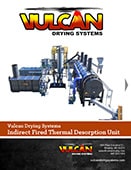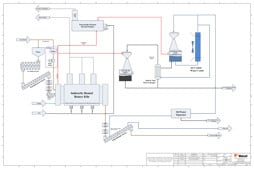Thermal Desorption
Vulcan TDUs are designed with minimal solids in recovered oil & low diesel cracking.
With a Vulcan® Drying Systems Thermal Desorption Unit, contaminated material is exposed to heat indirectly by slow contact with a slowly turning drum that is exposed to heat on the outer shell. Vaporized contaminants are separated from the solids in the sludge, resulting in an end product that can be disposed of easily and cost-effectively.
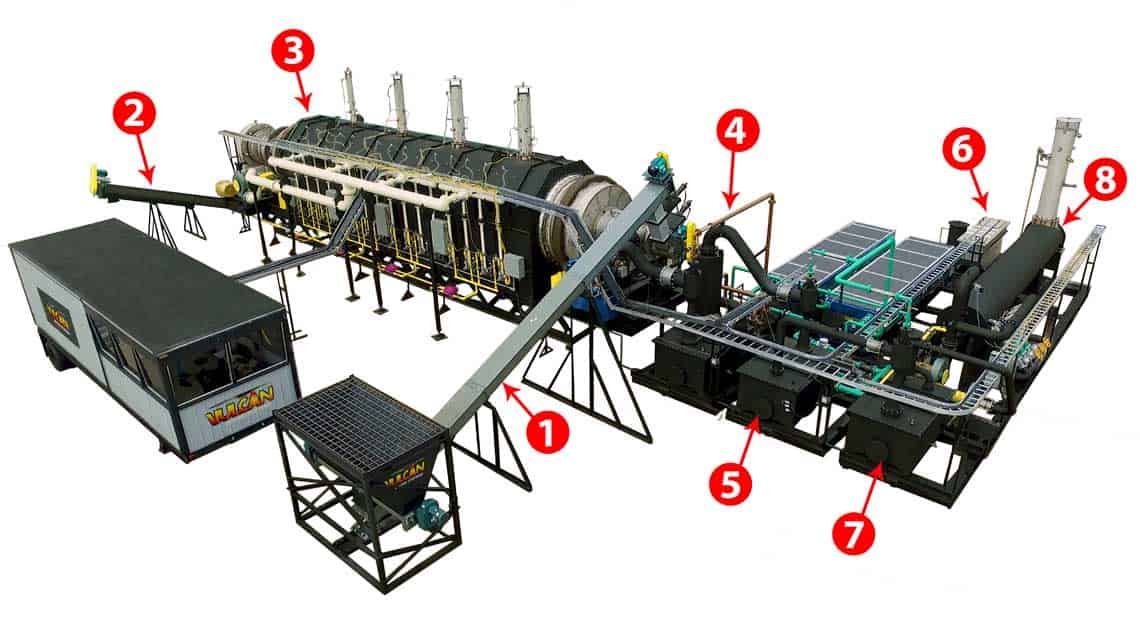
Main Process Components
1. Feed System
Live bottom feeder, incline screw conveyor, knife gate airlock valves, kiln feed screw conveyor. More InfoThe hydrocarbon contaminated feed is placed in the feed hopper, which includes a live bottom feeder. This live bottom feeder is VFD controlled in order to meter the feed into the system. The feed exits the live bottom feeder and travels via the transfer screw conveyor to two double knife gate airlock valves. These airlocks prohibit the flow of outside air into the process chamber, allowing the feed material to be introduced into the primary thermal treatment unit into a completely oxygen deficient environment.
2. Primary Thermal Desorption Unit
Indirect fired stainless steel rotary kiln with combustion chamber, gas or oil fired burners, gear drive powered by an electric motor. More InfoThis indirect fired rotary dryer has multiple zones, each with independent temperature controls. The drum is heated on the outside in order to maintain the integrity of the feed. Heat is transferred into the feed through conduction as the material is conveyed through the drum. The kiln operates in an oxygen deficient and slightly negative atmosphere. As the feed is heated, hydrocarbons, devolatized from the feed, are pulled out of the system in a counter-current direction to the material flow.
3. First Stage Oil Condenser
Oil condenser with tank, spray nozzle, cooling loop More InfoVapors from the thermal processor pass through an oil condenser. The oil condenser removes most hydrocarbons in the vapor stream. This recovered oil is cooled and pumped to the client's supplied storage tanks.
4. Second Stage Water Condenser
Water condenser with tank, spray nozzle, air cooled heat exchangers. More InfoAfter passing through the oil condenser, the vapor stream typically contains water vapor and very light hydrocarbons. This vapor is passed through a second stage water condenser in order to knock out water and other condensables
5. Oil Water Separator
Steel construction with float level. More InfoThe condensate from the second stage water condenser is pumped through a cooling loop and into an oil water separator, where residual oils are removed from the water.
6. Polishing Condenser
Mist eliminator and condenser with tank.
7. Thermal Oxidizer
Gas or oil fired burners and induced draft fan. More InfoThe non-condensable gases are pulled from the second stage by an induced draft fan and pushed into the thermal oxidizer.
2. Discharge System
Knife gate airlock valves, discharge cooling incline conveyor. More InfoThe residual solids are cleaned to the customer's requested standard, typically determined by regulatory requirements. Residual solids are usually cleaned to less than 1000 H.C. PPM for refinery waste applications and 5000 H.C. PPM for drill cuttings. Residual solids leave the process chamber and are discharged into a solids cooling conveyor. This cooling conveyor is typically a hydration screw utilizing atomized water to cool the solids before being discharged.
What Makes Our Equipment Unique?
THE ABILITY TO RECOVER THE DIESEL OR OIL IN A WAY WHICH MAXIMIZES THE RESALEABILITY OR USE AS A FUEL
MINIMAL SOLIDS IN THE RECOVERED OIL
Our technology overcomes many of the disadvantages associated with mechanical and other thermal technology for desorption of hydrocarbons. Our thermal desorption unit's process chamber is designed to have a large open capacity with low vapor exit velocity. By minimizing the entrained particulate in the vapor stream the recovered hydrocarbons are clean and can be used as fuel for the system or resold. Entrainment of large volumes of solids (a common problem with alternative technology) may cause the recovered oil to form an emulsion, reducing the value and potentially making the recovered oil a waste stream.
MINIMIZES CRACKING OF DIESEL
Oil based drilling muds contain large volumes of valuable, recoverable diesel. Cracking the diesel degrades the recoverability and greatly reduces the value. In order to maximize the volume and value of the recovered diesel or synthetic lubricants, it is important to apply heat to the feed progressively with maximum temperature control. Our technology incorporates multiple heating zones along the length of the drum. This allows us to apply controlled heating at different temperatures within each zone of the drum. Typically, the first zone evaporates the water. The middle zones are used to remove hydrocarbons down to less than one percent, and the last zone is a polishing zone to take off heavy hydrocarbons and meet regulatory standards for residual hydrocarbons. Proper temperature control during desorption as well as during cooling and condensing eliminates or reduces cracking of hydrocarbons
Vulcan® Drying Systems Systems Tank Bottoms Detailed Specifications
| Basis of Design - Throughput Calculations Based on - 50% Solids, 30% Hydrocarbons, 20% Water | |||
|---|---|---|---|
| Model | Tonnage | Drum | Portable |
| TB315 | 1 TPH | 3x15 | YES |
| TB420 | 2 TPH | 4x20 | YES |
| TB430 | 3 TPH | 4x30 | YES |
| TB525 | 5 TPH | 5x25 | YES |
| TB630 | 7.5 TPH | 6x30 | NO |
| TB735 | 10 TPH | 7x35 | NO |
* Varying capacities and feed consistency will change product capacity.
Additional Options
Heat Recovery
Using heat from a thermal oxidizer allows for preheating of combustion air in burners. This option can save up to 25% of fuel consumption in the system.
Waste Oil Burner System
An additional waste oil burner system consists of waste oil burners, fuel train, filters, and waste oil storage tank with heating elements. Reusing recovered oil as fuel will typically reduce fuel cost.
Discharge Quench
The stack on the discharge auger can be fitted with spray nozzles along the length of the stack. The quench spray removes excess particles from the gas stream before discharging steam into the atmosphere.
Nitrogen Generator
The swing adsorption nitrogen generator, with a nitrogen storage tank purges the system during start-up and shutdown. Nitrogen is also utilized during the process in order to keep O2 levels below the pre-detemined percent.
Portable
A portable option is available for some models, while the option of placing the entire system on skids is available for all models.
Learn More
Case Studies ( 6 )
Videos ( 7 )
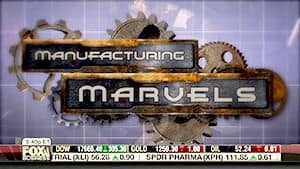
Vulcan® Drying Systems
Manufacturing Marvels

Vulcan® Drying Systems
Thermal Desorption System
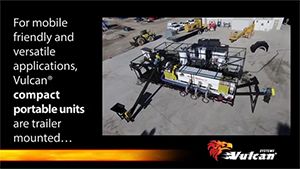
Vulcan® Drying Systems
Thermal Desorption Unit Systems

Vulcan® Drying Systems
Compact Mobile Thermal Desorption
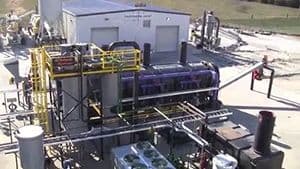
Vulcan® Drying Systems
IDR Indirect Fired Thermal Desorption










